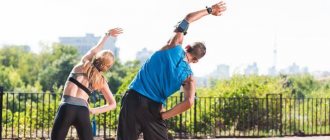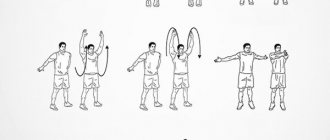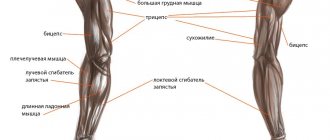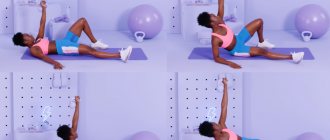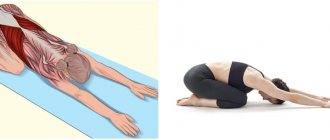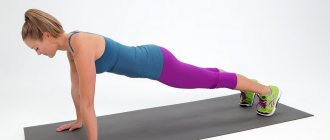Warm-up before starting a workout is a set of exercises that prepares the body for intense physical activity. With its help, you will halve the risk of sports injuries and increase the benefits of exercise. Duration – 5-15 minutes.
Warm-up can be general or specific. General – aerobic exercise. Its goal is to saturate the muscles with oxygen. With the help of a general aerobic warm-up, they increase muscle tone, warm up tendons and ligaments, speed up the heart rate, and slightly increase blood pressure. General warm-up options include jogging, jumping rope, cycling or an exercise bike.
Strength anaerobic warm-up prepares a specific group of muscles and joints for exercise with heavy sports equipment. It helps to feel the work of the muscles, improves its blood supply, and provides mild preliminary fatigue.
Content
- Benefits of warming up: Warming up the joint-ligamentous apparatus
- Warming up the muscles
- Cardiovascular preparation
- Smooth increase in body temperature
- Mental preparation
- Joint gymnastics
The secret of the benefits of joint gymnastics
Movement is the basis of every person’s life, so regular exercise will bring 100% benefits:
- joint fluid, a lubricant that makes joints mobile, is more actively produced - you become able to make movements that you could not even think about before, soreness in the joints goes away, they become more developed;
- Exercises that seem simple at first glance warm up all the muscles of the body - which means the mobility of the whole body increases together;
- Warm-up with elements of joint gymnastics is perfect for preparing for strength or cardio exercises;
- The risk of salt deposits on the affected joints is reduced;
- The musculoskeletal system is improved due to increased blood supply and saturation of cells with nutrients;
- A boost of energy and a feeling of vigor will be a pleasant addition, because physical activity activates the production of the happiness hormone;
- the functioning of the body's hormonal system improves.
The movements of joint gymnastics are easy and simple, do not require serious preparation and are suitable for people of all ages. At the same time, you will launch body renewal processes, strengthen muscles and ligaments, relieve fatigue and reduce the risk of serious diseases.
The benefits of warming up
Warming up the articular-ligamentous apparatus
Against the background of the average daily activity of a metropolis resident, the ligaments lose their elasticity. If they are not pre-warmed, the risk of sprains and tears during exercise increases.
Warming up before exercise increases the production of synovial fluid, which acts as an intra-articular lubricant, which increases joint mobility. Without it, the risk of arthrosis and arthritis increases in the medium term.
Warming up the muscles
“Cold” muscles are susceptible to spasms and cramps, sprains, tears and tears. On the contrary, warmed muscles contract and relax better, so the athlete’s strength capabilities increase.
Saturating your muscles with oxygen and nutrients also increases endurance during exercise. In addition, to form an attractive body shape and gain muscle mass, neuromuscular connections are needed, which are triggered during warm-up.
Cardiovascular preparation
At rest, the heart rate of an adult is 60-80 beats per minute. During physical activity it increases to 140-170. Without warming up, your internal “engine” figuratively switches from 1st automatic gear directly to 5th. Because of this, hypertrophy of the heart muscle gradually develops - “sports heart” syndrome.
It is often accompanied by functional cardiac disorders - irregular heart rhythm, rapid pulse, increased blood pressure. In order not to provoke the listed conditions, the heart rate should increase gradually - during the warm-up before training.
Smooth increase in body temperature
Normally, during physical activity, body temperature rises. Warming up triggers the natural process of thermoregulation, so your well-being does not deteriorate during the workout. Experts recommend training until light sweat appears on the forehead - this is a sign that the body is ready for more intense exercise.
Mental preparation
Psychology is an important component of the training and competitive process. Understanding that you are doing everything correctly, controlling muscle load, working according to plan, mentally sets you up for maximum results. At the same time, motivation increases, and training becomes more productive.
In addition, during warm-up, the synthesis of hormones responsible for energy production is activated, coordination of movements and attention are increased.
Psychology of warm-up
| Warming up is a good time to refresh your memory of your workout goals. |
Once again, remember the structure of the training - the duration of the intervals and the duration of the recovery periods. Revisit the goals of your training plan and think about how the upcoming workout relates to them. Taking the time to think about your overall goals during your warm-up will give you a boost of motivation and the necessary level of focus and positive energy to get the job done.
Warm-up can last an average of 3-10 minutes, depending on the upcoming load.
A classic warm-up before strength or cardio exercise usually consists of three parts, which are performed sequentially:
I. Warming up the joints
Usually these are rotational movements in the joints. Moreover, no matter which part of the body you train today and which you don’t, you need to warm up the whole body. This is especially true for the spine, knees and shoulder joints. It is good to warm up the spine with hyperextension and rotational movements.
II. General warm-up
This can be jogging, jumping exercises, rotational and inclined movements of the hands, head, shoulders, hip joints, knees, ankle joints, torso, simple aerobics or dancing movements. The exercises should be simple.
The goal is to speed up blood flow and metabolism. Your heart rate should reach 50-60% of maximum. Usually 4-5 minutes are enough for this. Thus, you mobilize the body’s main resources for the upcoming physical work. .
III. Prestretching
Another possible warm-up element could be pre-stretching.
Pre-stretching is a dynamic stretching of medium amplitude before starting a workout; pre-stretching movements should be in time with the music accompaniment of the workout. This part provides additional blood flow to the muscles and especially to the ligaments, improves joint mobility. Research shows that incorporating pre-stretching into the warm-up can have a positive effect on athletes' performance.
| It is worth noting that before training, stretching should be dynamic; static and ballistic stretching is contraindicated, as they can lead to a decrease in muscle performance, which in turn can lead to injury, and also reduces the performance of the student. |
Previously, we used static elements during the warm-up, placing them between the joint and dynamic warm-ups. However, according to the latest research data in this area, it can be concluded that it is more effective to gradually increase the heart rate - that is, increase the intensity, starting with a joint warm-up and continuing with a dynamic one, then moving on to the main part of the workout.
Thus, by carrying out simple preparatory manipulations, you will prepare yourself for the stress and be able to give your best, minimizing the risk of injury.
Author: Olga Evdokimova, MSc
Literature:
1. Bakal D.S. et al. Great Olympic Encyclopedia. – M.: Eksmo, 2008. – P. 559. – ISBN 978-5-699-27387-4. 2. Rob Slimmaker Ray Browning. Serious training for endurance athletes. – Tuloma, 2007. 3. Human physiology edited by Pokrovsky V.M., Korotko G.F. 2001 4. Serra AJ, Silva JA Jr, Marcolongo AA, Manchini MT, Oliveira JV, Santos LF, Rica RL, Bocalini DS., Experience in resistance training does not prevent reduction in muscle strength evoked by passive static stretching. Soligard T, Myklebust G, Steffen K, et al. (2008), Comprehensive warm-up program to prevent injuries in young female footballers: cluster randomized controlled trial. 5. Zagorodny G.M., Lositsky E.A., Medical and pedagogical aspects of injury prevention in sports and fitness. 6. David Behm, Monoem Haddad, Stretching during the Warm-up and to Increase Flexibility for Taekwondo.
Why is it dangerous not to warm up before an intense workout?
Exercising without warming up increases the risk of sprains, muscle strains, or joint injuries. They are followed by breaks in classes, that is, a stop in sports progress and a rollback of existing results. If you do not systematically warm up, this harms the heart muscle (in some cases, sudden surges in pressure and even fainting are possible).
In addition, the unpreparedness of the body's systems for intense training loads produces rapid fatigue and loss of enthusiasm during exercise. Ignoring the warm-up is a typical mistake of beginners who do not want to waste time and, as a result, often get injured in their first classes.
Tips to protect your knee joint and get rid of cracking
1. Regular physical activity and training - you need to strengthen your leg muscles and not forget about your knee muscles. Weight training, resistance training, or bodyweight exercises (such as squats and lunges) should be included in your fitness plan at least twice a week. 2. Warm up before training – muscles should be warmed up before training. You should not skip warming up, as it will help avoid injury or overuse. Heavy training can easily cause muscle and joint injuries. 3. Stretching - before and after training, you need to carefully stretch your muscles and joints. Regularly stretch the front and back of your thighs - first the quadriceps and then the hamstrings. 4. Take care of your shoes - wear comfortable shoes that do not pinch, especially if you stand a lot at work. 5. Maintain an optimal weight - this means avoiding being overweight or obese. Since excess body weight has a bad effect on the functioning of the knees and joints. Obesity is an established risk factor for the development of knee arthritis.
6. Sleep in the correct position - when you lie on your side, place a pillow between your knees. Your knees and spine will thank you very much. 7. Don't overload your joints - To avoid overloading your joints, you need to alternate between different types of movements. So walk, take the stairs, ride a bike, or go for a run. However, you should not practice the same type of physical activity. The same movement causes wear and tear on the same parts of the knee joint, while alternating physical activities stress different parts of the knee joint. 8. Don't sit for too long - Some scientists say that sitting for 30 minutes is too long, and some recommend walking only after 45-60 minutes. The time interval depends on you, but you definitely shouldn’t sit for 8 hours of working time. Take a break and walk a little. Even standing for long periods of time is bad for your joints and knees, so be sure to take a break for a walk. 9. Don't risk slipping, tripping or falling - don't underestimate weather conditions and always wear appropriate footwear for the season. If it is slippery outside, it is better not to wear shoes with heels or smooth soles. Otherwise, you expose yourself to risks that may have unforeseen consequences. 10. Do the following 10 exercises - Stretching, relaxing and strengthening your muscles can help you loosen up tight knee muscles and reduce cracking, crunching and pain. Perform the following exercises during your workouts at least twice a week.
Warm-up plan before working out in the gym
Joint gymnastics
Rotational movements, turns and/or bends in each direction, starting from the neck and ending with the ankle joint. When stretching your neck, avoid rotation, as this part of the spine is extremely vulnerable and any axial loads are potentially dangerous.
Tilt your head to the sides, forward, and gently back (the chin reaches toward the ceiling). After this, carefully knead the rotator cuff of the shoulder joint - to do this, swing in different planes - to the sides, back, up.
Then perform rotational movements in one direction and the other in:
- shoulder joints;
- elbows;
- brushes;
- lumbar spine (if axial loads are contraindicated, replace rotations with tilts);
- hip joints;
- knee;
- ankle.
Do 10-15 repetitions at an average pace. The time for performing joint warm-up before training is 2-3 minutes.
Stretching
Dynamic stretching exercises for all muscle groups mobilize muscle tissue, stretch fascia, stimulate the flow of oxygen to muscle cells, and prepare muscles for power load. The complex is carried out on a top-down basis. Pay special attention to large muscle groups - pectoral muscles, latissimus dorsi, spinal extensors, hip adductors and hamstrings. At the points of maximum tension, it is enough to linger for 5-10 seconds.
Hanging on a bar is suitable for stretching all muscles. To stretch your pectoral muscles, place one hand on a squat rack and lean your whole body forward or spread your arms out to the sides and back as far as possible. To stretch your lower back and hamstrings, do a straight-legged forward bend or hyperextension. Lunges are suitable for stretching the leg muscles.
When performing stretching exercises, you should feel muscle tension, but not pain or discomfort. The complex execution time is 2-3 minutes.
Cardio
Cardio warm-up prepares the cardiovascular system for physical activity. Perform light aerobic exercise with a heart rate of 130 beats per minute. This speeds up metabolism and triggers the processes of lipolysis - the oxidation of adipose tissue.
Cardio warm-up options include walking on a treadmill, elliptical or stepper, walking with high knees, arms and legs. The duration of the complex is up to 5 minutes. Finish when you feel that your body temperature has increased slightly.
Life hack: start your cardio warm-up wearing relatively warm sportswear, such as a sweatshirt, and when you warm up, take it off.
Strength warm-up
For the strength phase of the warm-up, experts recommend CrossFit exercises with minimal weights - no more than 20-30% of the workload. Pay special attention to the muscle group you are training today.
For example, on shoulder day do straight arm swings with ~4 kg dumbbells, on arm day do curls with dumbbells, on chest day do wall push-ups, on leg day do 3 sets of squats. You can perform exercises from the main workout, but in a simplified technique. When performing a strength warm-up, it is important to isolate each muscle group and load it specifically. Therefore, choose isolated exercises, and not, for example, deadlifts.
Options for strength exercises to warm up before training (do it selectively):
- Neck – bend the neck while lying down with a disc on the back of the head or on the forehead. 2 sets of 20 reps.
- Shoulders – standing, swinging dumbbells to the sides or in front of you//barbell row with a wide grip to the chin. 2 sets of 25 reps.
- Chest – push-ups//crossover crossover. 3 sets of 20 reps.
- Back – hyperextension//upper side row with wide grip//pull-ups with wide grip. 2 sets of 15 reps.
- Arms – lifting from the lower block with an EZ-handle to the biceps//extension of the arms from the upper block with a rope handle. 3 sets of 20 reps.
- Press crunches while sitting in a machine. 2 sets of 25 reps.
- Legs – squats with your own weight // leg abduction, sitting in a machine // leg curls, sitting in a machine // leg extensions, sitting in a machine. 3 sets of 20 reps.
The duration of the strength warm-up complex is no more than 5 minutes.
Is running really beneficial?
Before moving on to warming up, I suggest you remember the benefits of running. The right information feed will definitely motivate you and help you get off your butt.
So:
- Running has a beneficial effect on the respiratory system. Active breathing during running saturates the organs with oxygen, and deep and rare breathing increases the vital capacity of the lungs and their ventilation ability, which ensures cleansing of the organ. If you're ready for some intense breathing training, read your favorite poem or sing a song halfway through your race.
- Thanks to intense breathing, the runner gets a boost of energy that lasts for an hour after training.
- The functioning of the cardiovascular system improves. Regular jogging lowers your heart rate. Over eight weeks it drops by about 4%. The heart muscle itself is trained, the elasticity of blood vessels is strengthened, thanks to the alternating tension of the leg muscles.
- The oscillatory movement of the body up and down when running has a beneficial effect on lymph and blood.
- The load on the diaphragm simultaneously massages the abdominal cavity.
- Running is a great assistant for losing weight. While running, almost all muscle groups work, calorie consumption increases and metabolism accelerates. Intense jogging at a comfortable pace helps best. An hour-long workout will save you from 500 to 1000 calories. For maximum efficiency, perform periodic accelerations or run obstacle courses. This point can be studied in more detail in the article Losing weight with interval running.
- Training improves the functioning of the musculoskeletal system, preventing the occurrence of radiculitis and arthrosis. Be sure to watch the video on the ABCs of running from the guys from CyclON.
- Scientists have proven that after regular exercise, partial regeneration of liver tissue occurs due to the supply of large amounts of oxygen.
- Jogging increases endurance, especially if you alternate 500 meters of maximum effort running with the same distance jogging.
- Light jogging has a beneficial effect on the psyche. The mood is lifted due to the production of one of the hormones of happiness - endorphin.
- Changes occur in the biochemical composition of the blood, immunity and resistance to viruses increase.
- Running on steps is very useful; at home you can do the exercise on the spot, raising your knees high; alternating the type of running surface surface will also have a positive effect.
Warm up before training at home
You can exclude cardio exercises from warming up before training at home, since home exercises are not as intense as in the gym and increase the heart rate slightly. If desired, the treadmill can be replaced by running in place or “shadow boxing” - an imitation of boxing sparring with an imaginary opponent.
Cardio warm-up can be replaced with exercises for the whole body, such as jumpingjack - jumping while clapping overhead, or squats and throwing a ball at the wall. If home workout time is limited, joint exercises and stretching are sufficient.
Training rules
When performing gymnastics, the following rules must be observed:
- when performing a set of measures for therapeutic purposes, you must first visit a doctor and get his recommendations;
- gymnastics is best done in between meals; it is not recommended to do exercises on an empty stomach or with a full stomach;
- the load must be increased gradually, you cannot start with complex exercises;
- You need to conduct classes daily only then a noticeable result will appear;
- It is strictly forbidden to do gymnastics for joint pain.
With arthrosis, it is necessary to develop not only the affected joint, but the entire musculoskeletal corset. For a diseased joint, stretching exercises are well suited, and for healthy joints, a running type of exercise is prescribed.
